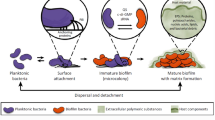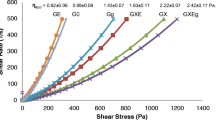Abstract
The medical importance of bacterial biofilms has increased with the recognition of biofilms as one of the major contributors to the slow or non-healing chronic wounds such as diabetic foot ulcers, venous leg ulcers, and pressure ulcers. Being a protected community of microorganisms, biofilms are notoriously refractory to antibiotic treatments. As the conventional treatment modalities have proven ineffective, this study provides the in vitro evidence to support the use of a novel combination of DispersinB® antibiofilm enzyme that inhibits biofilm formation and disperses preformed biofilm, and thus making the biofilm bacteria more susceptible to a broad-spectrum KSL-W antimicrobial peptide. The combination of DispersinB® and KSL-W peptide showed synergistic antibiofilm and antimicrobial activity against chronic wound infection associated biofilm-embedded bacteria such as Methicillin-resistant Staphylococcus aureus (MRSA), Staphylococcus epidermidis, Coagulase-negative Staphylococci (CoNS), and Acinetobacter baumannii. In addition, the wound gel formulation comprising DispersinB®, KSL-W peptide, and a gelling agent Pluronic F-127 showed a broad-spectrum and enduring antimicrobial activity against test organisms. Furthermore, as compared to commercial wound gel Silver-Sept™, DispersinB®-KSL-W peptide-based wound gel was significantly more effective in inhibiting the biofilm-embedded MRSA, S. epidermidis, CoNS, Vancomycin-resistant Enterococci, A. baumannii, Klebsiella pneumoniae, and Pseudomonas aeruginosa (P < 0.05). Thus, this study provides promising evidence for the potential application of antibiofilm-antimicrobial DispersinB®-KSL-W wound gel in chronic wound management.


Similar content being viewed by others
References
Gottrup F (2004) A specialized wound-healing center concept: importance of a multidisciplinary department structure and surgical treatment facilities in the treatment of chronic wounds. Am J Surg 187:38S–43S
Konturek PC, Brzozowski T, Kouturek SJ, Kwiecien S, Dembinski A, Hahn EG (2001) Influence of bacterial lipopolysaccharide on healing of chronic experimental ulcer in rat. Scand J Gastroenterol 36:1239–1247
Gjodsbol K, Christensen JJ, Karlsmark T, Jorgensen B, Klein BM, Krogfelt KA (2006) Multiple bacterial species reside in chronic wounds: a longitudinal study. Int Wound J 3:225–231
James GA, Swogger E, Wolcott R, Pulcini E, Secor P, Sestrich J, Costerton JW, Stewart PS (2008) Biofilms in chronic wounds. Wound Repair Regen 16:37–44
Singh VA, Barbul A (2008) Bacterial biofilms in wounds. Wound Repair Regen 16:1
Costerton JW (2004) A short history of the development of the biofilm concept. In: Ghannoum M, O’Toole GA (eds) Microbial biofilms. ASM Press, Washington, DC, pp 4–19
Wolcott RD, Rhoads DD (2008) A study of biofilm-based wound management in subjects with critical limb ischemia. J Wound Care 17:145–155
Hong SY, Oh JE, Kwon MY, Choi MJ, Lee JH, Lee BL, Moon HM, Lee KH (1998) Identification and characterization of novel antimicrobial decapeptides generated by combinatorial chemistry. Antimicrob Agents Chemother 42:2534–2541
Na DH, Faraj J, Capan Y, Leung KP, DeLuca PP (2007) Stability of antimicrobial decapeptide (KSL) and its analogues for delivery in the oral cavity. Pharm Res 24:1544–1550
Kaplan JB, Ragunath C, Ramasubbu N, Fine DH (2003) Detachment of Actinobacillus actinomycetemcomitans biofilm cells by an endogenous beta- hexosaminidase activity. J Bacteriol 185:4693–4698
Kaplan JB (2009) Therapeutic potential of biofilm-dispersing enzymes. Int J Artif Organs 32:545–554
Leung K-P, Abercrombie JJ, Campbell TM, Gilmore KD, Bell CA, Faraj JA, DeLuca PP (2009) Antimicrobial peptides for plaque control. Adv Dent Res 21:57–62
Dumortier G, Grossiord JL, Agnely F, Chaumeil JC (2006) A review of poloxamer 407 pharmaceutical and pharmacological characteristics. Pharm Res 23:2709–2728
Concannon SP, Crowe TD, Abercrombie JJ, Molina CM, Raj PA, Leung K-P (2003) Susceptibility of oral bacteria to an antimicrobial decapeptide. J Med Microbiol 52:1083–1093
Castellano JJ, Shafii SM, Ko F, Donate G, Wright TE, Mannari RJ, Payne WG, Smith DJ, Robson MC (2007) Comparative evaluation of silver-containing antimicrobial dressings and drugs. Int Wound J 4:114–122
Izano EA, Sadovskay I, Vinogradov E et al (2007) Poly-N-acetylglucosamine mediates biofilm formation and antibiotic resistance in Actinobacillus pleuropneumoniae. Microb Pathog 43:1–9
Gawande PV, Yakandawala N, LoVetri K, Madhyastha S (2011) In vitro antimicrobial and antibiofilm activity of DispersinB®-Triclosan wound gel against chronic wound associated bacteria. Open Antimicrob Agents J 3:12–16
Donlan RM, Costerton JW (2002) Biofilms: survival mechanisms of clinically relevant microorganisms. Clin Microbiol Rev 15:167–193
Choi AHK, Slamti L, Avci FY, Pier GB, Maria-Litran T (2009) The pgaABCD locus of Acinetobacter baumannii encodes the production of poly-β-N-acetylglucosamine, which is critical for biofilm formation. J Bacteriol 191:5953–5963
Itoh Y, Wang X, Hinnebusch BJ, Preston JF, Rome T (2005) Depolymerization of β-1,6-N-acetyl-d-glucosamine disrupts the integrity of diverse bacterial biofilms. J Bacteriol 187:382–387
Darouiche RO, Mansouri MD, Gawande PV, Madhyastha S (2009) Antimicrobial and antibiofilm efficacy of triclosan and DispersinB® combination. J Antimicrob Chemother 64:88–93
Donelli G, Francolini I, Romoli D, Guaglianone A, Piozzi C, Ragunath C, Kaplan JB (2007) Synergistic activity of dispersin B and cefamandole nafate in inhibition of staphylococcal biofilm growth on polyurethanes. Antimicrob Agents Chemother 51:2733–2740
Izano EA, Wang H, Ragunath C, Kaplan JB (2007) Detachment and killing of Aggregatibacter actinomycetemcomitans biofilms by dispersin B and SDS. J Dent Res 86:618–622
Gotz F (2002) Staphylococcus and biofilms. Mol Microbiol 43:1367–1378
Loh JV, Percival SL, Woods EJ, Williams NJ, Cochrane CA (2009) Silver resistance in MRSA isolated from wound and nasal sources in humans and animals. Int Wound J 6:32–38
Whitchurch CB, Tolker-Nielsen T, Ragas PC, Mattick JS (2002) Extracellular DNA required for bacterial biofilm formation. Science 295:1487
Flemming HC, Neu TR, Wozniak DJ (2007) The EPS matrix: the house of biofilm cells. J Bacteriol 189:7945–7947
Marvasi M, Visscher PT, Casillas Martinez L (2010) Exopolymeric substance (EPS) from Bacillua subtilis: polymers and genes encoding their synthesis. FEMS Microbiol Lett 313:1–9
Yeaman MR, Yount NY (2003) Mechanisms of antimicrobial peptide action and resistance. Pharmacol Rev 55:27–55
Harrison JJ, Turner RJ, Joo DA, Stan MA, Chan CS, Allan ND, Vrionis HA, Olson ME, Ceri H (2008) Copper and quaternary ammonium cations exert synergistic bactericidal and antibiofilm activity against Pseudomonas aeruginosa. Antimicrob Agents Chemother 52:2870–2881
Semlali A, Leung K-P, Curt S, Rouabhia M (2011) Antimicrobial decapeptide KSL-W attenuates Candida albicans virulence by modulating its effects on toll-like receptor, human β-defensin, and cytokine expression by engineered human oral mucosa. Peptide 32:859–867
Acknowledgments
This work was supported by the U.S. Army Medical Research and Materiel Command, Award W81XWH-11-P-0321.
Author information
Authors and Affiliations
Corresponding author
Rights and permissions
About this article
Cite this article
Gawande, P.V., Leung, K.P. & Madhyastha, S. Antibiofilm and Antimicrobial Efficacy of DispersinB®-KSL-W Peptide-Based Wound Gel Against Chronic Wound Infection Associated Bacteria. Curr Microbiol 68, 635–641 (2014). https://doi.org/10.1007/s00284-014-0519-6
Received:
Accepted:
Published:
Issue Date:
DOI: https://doi.org/10.1007/s00284-014-0519-6




